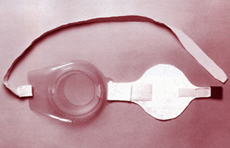Brassiere for Radiation Treatment RSD BR-100
A Guide to Better Radiation Treatment
The Treatment BrassiereCup Library
- Basic library of 20 left and 20 right ipsilateral cups.
- Special cup sizes available on two-day notice.
- Applicable to most patients.
- Repeatable ipsilateral breast shape and position throughout course of treatment.
- Eliminates mammary folds.
- Reduces dose to lungs, heart and ribs.
- Round cotton brassiere panel compresses contralateral breast and moves it as far as possible from beams.
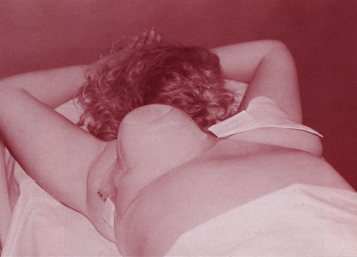
New Breast Configuration with Brassiere
Skin Dose
Data on increased skin dose due to the ipsilateral cup were submitted to the FDA. These data provided a comparison of skin dose increased by the Treatment Brassiere to the increase found for various thermoplastic positioning devices on the market. The skin dose due to the cup material (0.25 mm thick for small cups to about 0.63 mm thick for very large cups) was found to be substantially less than for other positioning devices. The FDS has issued a 510-(k) marketing clearance for the Treatment Brassiere.
Reduction of Unwanted DoseThe semi-rigid, transparent brassiere cups reshape the ipsilateral breasts to symmetrical forms which rise directly up from the chest wall. The volume of irradiated tissue decreases substantially by eliminating mammary folds, and the unwanted radiation to the contralateral breast, heart, lungs, and ribs is greatly reduced. The dose distribution in the breast becomes more uniform.
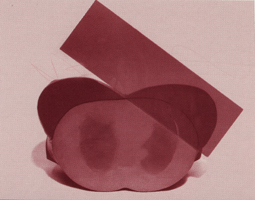 Cross Section of Phantom with Unconfined Breast Shape |
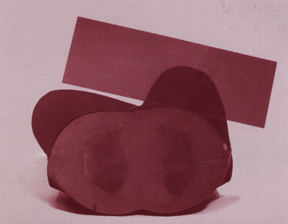 Cross Section of Phantom with Breasts Reshaped by Treatment Brassiere |
Repeatability of Position
The ipsilateral cup is positioned repeatably on the patient by markings made on the patient's skin through small holes at the medial, lateral, and superior aspects of the cup.
Increased Flexibility of Fitting By Truncation of CupsA Pattern and then a cup are made of the reshaped breast, but the anterior portion of the cup is cut off. These truncated cups permit the fitting of breasts of moderately different volumes into the same cup, while maintaining full skin-sparing in the most sensitive area.
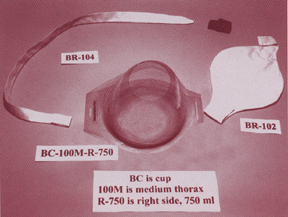 Exploded View of Typical Brassiere |
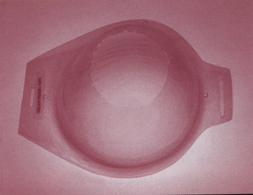 Breast Cup Showing Mark-Off Holes |
The fabric covering which compresses the contralateral breast affords a base for a lead shield to reduce scatter dose. A 0.015 in. (0.38 mm) sheet of lead is easily formed by hand into a cup which can be placed over the breast when the patient is supine and which remains in place by gravity. The plies substantially reduce scatter dose to the contralateral breast. However, shielding must be used judiciously if primary beams pass through it.
Cup SelectionCups are divided into four groups corresponding to small thoraxes (chest breadths from 27 to 32 cm), medium thoraxes (32 to 36 cm), large thoraxes (36 to 42 cm), and extra large thoraxes (over 42 cm).
The proper cup is selected for a new patient by measuring her chest breadth when supine and while wearing her clothing brassiere. This indicates the group from which the best fitting cup will be found. The clothing brassiere size is a rough guide to the first cup to be tried. Thereafter larger or smaller cups will be tested to find the best cup. (Note that there is poor correlation between the brassiere size and breast volume of a patient). L or R marks on cups, indicate left or right sides. Left and right cups are not interchangeable.
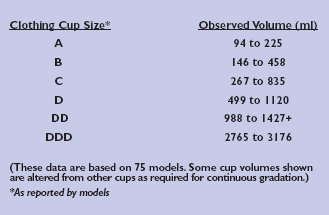
Preliminary Patient Data
Patient Measurement Charts are used to facilitate selection of the proper cup for a patient. Chest breadth is measured with a patient caliper, so the correct group size can be selected.
The chart provides for recording cup hole locations, applicable (of course) to both phantom and patient.
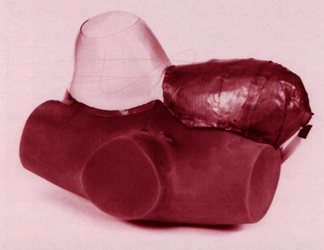
Lead Shield Over Contralateral Breast
Although the possibility of cross-contamination is remote, it can be eliminated almost completely by lining cups with Saran wrap while the proper cup size is being selected.
Users have recommended that cups be dedicated to the same patient throughout the course of treatment, after which it is to be discarded. This eliminates further need for the Saran wrap, and there is no risk of cross contamination from cups.
| Patient Data | ||||
|
Dimension with Caliper Patient Chest Breadth (supine with brassiere) cm |
_______________________________________________________________ |
|||
|
IPSILATERAL-CUP HOLES DIMENSIONS WITH 3DMDTM (cm) |
||||
| Medial | Lateral | Superior | ||
| Along table length (CC) | __________ | __________ | __________ | |
| Across table (Lateral) | __________ | __________ | __________ | |
| Normal to the table (AP) | __________ | __________ | __________ | |
|
Note: Some dimensions are taken with either end of the pointed transverse pin through the AP rod
(near the bottom of the rod) in contact with the skin or the phantom. No correction is needed for the pin length. |
||||
| Patient Measurement Chart | ||||
A New Level of Quality Assurance
Planned breast treatments are essentially predictive. Every link in the chain connecting dose prescription to dose distribution must be accurate, or have only small, off-setting errors. However, a patient's dose distribution within the ipsilateral breast and thorax cannot be measured.
The treatment planning system, therapy machines, patient positioning, human performance, and many other factors cannot be checked as a whole, because there is no clinically-feasible method for comprehensive dose measurements within the ipsilateral breast and thorax.
The Treatment Brassiere serves another extremely important function, in addition to improving treatments. By standardizing breast contours and almost eliminating mobility during the course of treatment, it becomes possible to accurately represent the treated breast of a patient by a tissue-equivalent phantom breast. Consequently, it is possible to deliver a treatment to a phantom breast which will have the same dose distribution as if delivered to a patient's corresponding breast. However, only the phantom treatment can be measured in sufficient detail for evaluation.
Reproducing and Measuring the Breast Treatment of a Patient by a PhantomThe substitute patient consists of (1) a breast, which fits precisely into a cup which, in turn, has been molded about a reshaped ipsilateral patient breast; (2) a thorax; and (3) an adaptor section molded integrally with the breast. This section is required because the breast must be fitted to a phantom that is smaller than the patient. A line is scribed to distinguish the breast proper from the adaptor (which represents chest-wall tissue).
This assembly is a fully valid substitute for a patient, except for a relatively minor factor. The adaptor section cannot duplicate completely the contours of a patient, but this section represents tissue for which doses are to be minimized; the exact magnitude of these doses is not a critical issue.
The basic cup library consists of a gradation of breast volumes divided into four groups, based upon chest breadth. Total Quality Assurance may be implemented with any selected series of breast volumes, which are based upon the volumes of the breasts of individual patients.
| Small Left Side (Chest Breadths: 27-32 cm) | |
|---|---|
| Model | Description |
| BR-100SL-200 | 200 cc |
| BR-100SL-300 | 300 cc |
| BR-100SL-400 | 400 cc |
| BR-100SL-500 | 500 cc |
| BR-100SL-600 | 600 cc |
| Medium Left Side (Chest Breadths: 32-36 cm) | |
|---|---|
| Model | Description |
| BR-100ML250 | 250 cc |
| BR-100ML500 | 500 cc |
| BR-100ML750 | 750 cc |
| BR-100ML-1000 | 1000 cc |
| BR-100ML-1250 | 1250 cc |
| Large Left Side (Chest Breadths: 36-42 cm) | |
|---|---|
| Model | Description |
| BR-100LL-500 | 500 cc |
| BR-100LL-750 | 750 cc |
| BR-100LL-1000 | 1000 cc |
| BR-100LL-1250 | 1250 cc |
| BR-100LL-1500 | 1500 cc |
| Extra Large Left Side (Chest Breadths: over 42 cm) | |
|---|---|
| Model | Description |
| BR-100XLL-1000 | 1000 cc |
| BR-100XLL-1500 | 1500 cc |
| BR-100XLL-2000 | 2000 cc |
| BR-100XLL-2500 | 2500 cc |
| BR-100XLL-3000 | 3000 cc |
| Small Right Side (Chest Breadths: 27-32 cm) | |
|---|---|
| Model | Description |
| BR-100SR-200 | 200 cc |
| BR-100SR-300 | 300 cc |
| BR-100SR-400 | 400 cc |
| BR-100SR-500 | 500 cc |
| BR-100SR-600 | 600 cc |
| Medium Right Side (Chest Breadths: 32-36 cm) | |
|---|---|
| Model | Description |
| BR-100MR-250 | 250 cc |
| BR-100MR-500 | 500 cc |
| BR-100MR-750 | 750 cc |
| BR-100MR-1000 | 1000 cc |
| BR-100MR-1250 | 1250 cc |
| Large Right Side (Chest Breadths: 36-42 cm) | |
|---|---|
| Model | Description |
| BR-100LR-500 | 500 cc |
| BR-100LR-750 | 750 cc |
| BR-100LR-1000 | 1000 cc |
| BR-100LR-1250 | 1250 cc |
| BR-100LR-1500 | 1500 cc |
| Extra Large Right Side (Chest Breadths: over 42 cm) | |
|---|---|
| Model | Description |
| BR-100XLR-1000 | 1000 cc |
| BR-100XLR-1500 | 1500 cc |
| BR-100XLR-2000 | 2000 cc |
| BR-100XLR-2500 | 2500 cc |
| BR-100XLR-3000 | 3000 cc |



